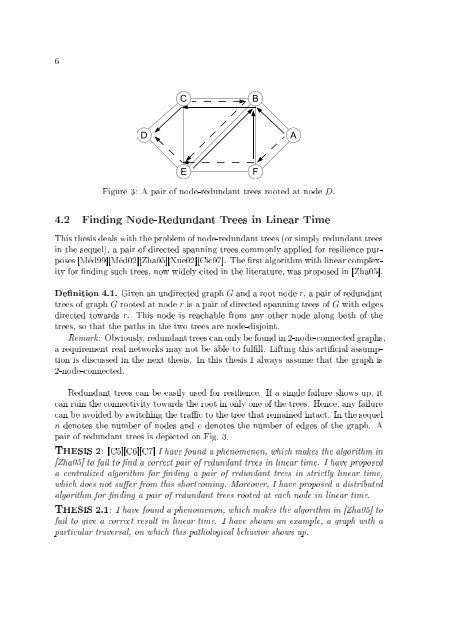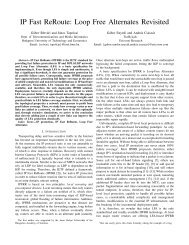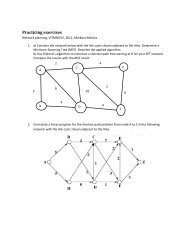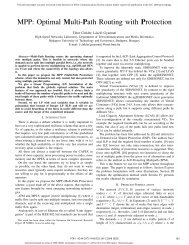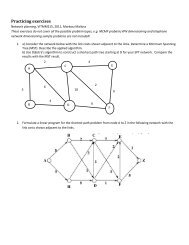NOVEL ALGORITHMS FOR IP FAST REROUTE (DRAFT)
NOVEL ALGORITHMS FOR IP FAST REROUTE (DRAFT)
NOVEL ALGORITHMS FOR IP FAST REROUTE (DRAFT)
You also want an ePaper? Increase the reach of your titles
YUMPU automatically turns print PDFs into web optimized ePapers that Google loves.
6Figure 3: A pair of node-redundant trees rooted at node D.4.2 Finding Node-Redundant Trees in Linear TimeThis thesis deals with the problem of node-redundant trees (or simply redundant treesin the sequel), a pair of directed spanning trees commonly applied for resilience purposes[Méd99][Méd02][Zha05][Xue02][Cic07]. The rst algorithm with linear complexityfor nding such trees, now widely cited in the literature, was proposed in [Zha05].Denition 4.1. Given an undirected graph G and a root node r, a pair of redundanttrees of graph G rooted at node r is a pair of directed spanning trees of G with edgesdirected towards r. This node is reachable from any other node along both of thetrees, so that the paths in the two trees are node-disjoint.Remark: Obviously, redundant trees can only be found in 2-node-connected graphs,a requirement real networks may not be able to fulll. Lifting this articial assumptionis discussed in the next thesis. In this thesis I always assume that the graph is2-node-connected.Redundant trees can be easily used for resilience. If a single failure shows up, itcan ruin the connectivity towards the root in only one of the trees. Hence, any failurecan be avoided by switching the trac to the tree that remained intact. In the sequeln denotes the number of nodes and e denotes the number of edges of the graph. Apair of redundant trees is depicted on Fig. 3.THESIS 2: [C5][C6][C7] I have found a phenomenon, which makes the algorithm in[Zha05] to fail to nd a correct pair of redundant trees in linear time. I have proposeda centralized algorithm for nding a pair of redundant trees in strictly linear time,which does not suer from this shortcoming. Moreover, I have proposed a distributedalgorithm for nding a pair of redundant trees rooted at each node in linear time.THESIS 2.1: I have found a phenomenon, which makes the algorithm in [Zha05] tofail to give a correct result in linear time. I have shown an example, a graph with aparticular traversal, on which this pathological behavior shows up.


